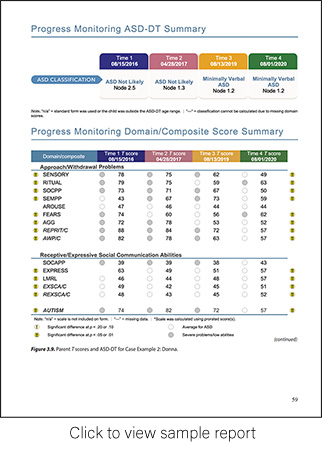Register now and start:
- Accessing PAR Training
- Shopping PAR products & tools
- Using online assessments with PARiConnect

Notice: PAR will close at 4:00 PM EST on Tuesday, December 23rd in observance of the Christmas holiday. Orders placed after 4:00 PM EST on the 23rd, will ship on Friday, December 26th when PAR re-opens at 8:00 AM EST. We wish everyone celebrating a joyful holiday season!

Donna was first referred around age 2 years because of delayed milestones and irritable behaviors. Over the next few years repeat assessment indicated little progress with intervention, and she was eventually diagnosed with and treated for inflammatory bowel disease. She was re-assessed a third time just before she turned 5 years old; she was diagnosed with autism, and her PDDBI at that time showed ongoing concerns with expression language and social skills.

Donna was evaluated for a fourth time with the PDDBI one year later, when she was almost six years old, to assess for treatment gains and to help update her therapy needs. Compared to her evaluation one year prior, Donna’s PDDBI T scores showed significant improvements (denoted by “!” and “!!” icons in the score table, with the “4” icon consistently indicating that time 4 scores were significantly better) in problem behaviors in three AWP domains and the accompanying composite. In each case, the magnitude of change was seen in only small percentages of the progress monitoring sample (less than 7%), indicating that this magnitude of change is unexpected in the absence of intervention. In the REXSCA dimension, the EXPRESS and LMRL domains showed significant improvements in abilities, as did both composites. A significant decrease in the overall AUTISM composite reflected these improvements.
These gains were directly related to her ongoing treatment without the interference of medical symptoms, as her bowel condition had been successfully treated, and they had been targeting social pragmatics and sensory tolerances with behavioral desensitization over the previous year. Her evaluating clinician recommended maintaining several of her treatment goals and setting additional goals for expressive language and social overtures.
The PDD Behavior Inventory (PDDBI) is a standardized assessment tool designed to evaluate both adaptive and maladaptive behaviors in children with Autism Spectrum Disorder (ASD). Developed for use by clinicians, educators, and researchers, the PDDBI provides a comprehensive profile of a child’s functioning across multiple domains, including social communication, sensory responses, and behavior regulation. Its unique multirater format allows for input from both parents and teachers, offering valuable insights into how a child’s behaviors may vary across settings. This dual perspective supports more accurate diagnoses, individualized intervention planning, and progress monitoring, making the PDDBI a vital resource in the assessment and support of children with ASD.